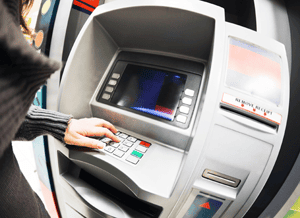
Will Cardless Cash Catch On?
 Apple Pay, where consumers can pay for products using their iPhone, is widely known but not widely used. Will cardless cash do any better?
Apple Pay, where consumers can pay for products using their iPhone, is widely known but not widely used. Will cardless cash do any better?
Six banks in the United States have begun offering a way for customers to get cash from an ATM using their smartphones, according to Doug Brown, senior vice president and general manager at FIS Mobile, a division of the core processing vendor FIS. Twenty-five more are working on rolling out the product, which is part of FIS’ mobile banking platform. The service lets customers use their smartphones to get cash from an ATM, which is billed as a way to increase convenience and security. So far, no adoption figures are being disclosed, Brown says.
“[The banks] are all pleased because adoption is far above what they expected,’’ he says. However, only about 39 percent of smartphone users with a bank account actually use their banks’ mobile banking app, according to a March survey by the Federal Reserve. It’s available. It’s free. And not even half are using it.
But Brown says he expects mobile banking usage to pick up in general, and that tens of thousands of users in the Chicago area have tried out the cashless card service, to rave reviews. BMO Harris Bank, which has $98 billion in assets, and $20 billion asset Wintrust Financial Corp., are offering the service and both are based in the Chicago market.
BMO Harris calls it mobile cash, and it works after you log into your mobile banking app on your phone. You can order up an ATM withdrawal at any of 900 of the bank’s ATMs and your phone communicates with the ATM near you, which flashes a QR code (a machine readable label) that you can scan into your phone. The ATM delivers your cash and a receipt is delivered electronically. You never touch the ATM screen.
All of this is done in about 15 seconds, versus 45 seconds on average for an ATM transaction, Brown says. BMO Harris, which launched mobile cash in March, also launched Touch ID for the iPhone in late July, where you can save even more time by not using a log in and password to access your mobile account—you just use your fingerprint. A PIN can also be used in lieu of a log in and password to save time. The fingerprint ID is available, for now, using the iPhone 5s and newer versions, with a similar Android service available soon.
Brown says cardless cash is secure because each transaction is tokenized, so no data from the transaction is stored on your phone. A secure cloud houses the QR code, Brown says. Fraud is always a possibility, but “it really minimizes the exposure compared to the magnetic stripe world,’’ he said.
Skimming, where fraudsters put cameras on ATMs to record card and PINs, is not possible with this service. “The security that is commonly used at ATMs is over 30 years old,’’ says Douglas Peacock, vice president of mobile banking for BMO Harris, which is a subsidiary of $633 billion asset Toronto-based BMO Financial Group. “It’s been that way since cards were introduced.”
The biggest challenge so far? Marketing. BMO has a video tutorial for customers who log into online or mobile banking. Wintrust used social media, billboards and TV ads and the Chicago Cubs’ mascot to promote the service. “Like anything that’s brand new, it takes a little bit of learning,” Peacock says.


